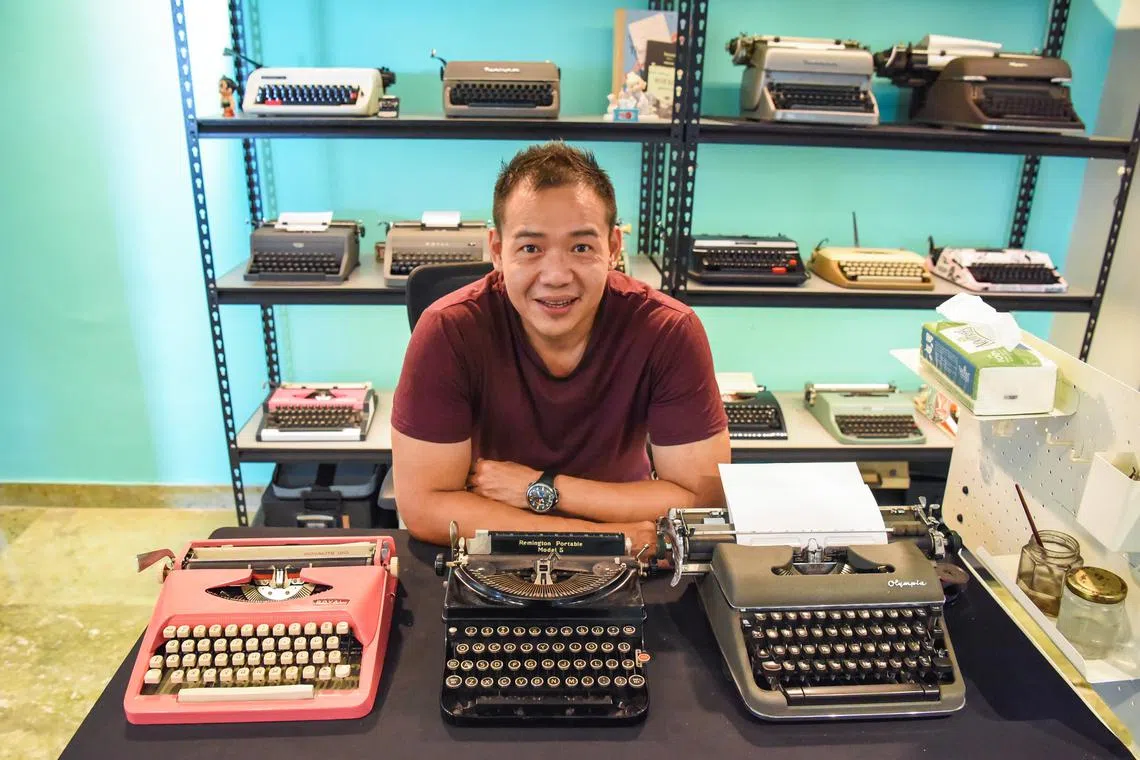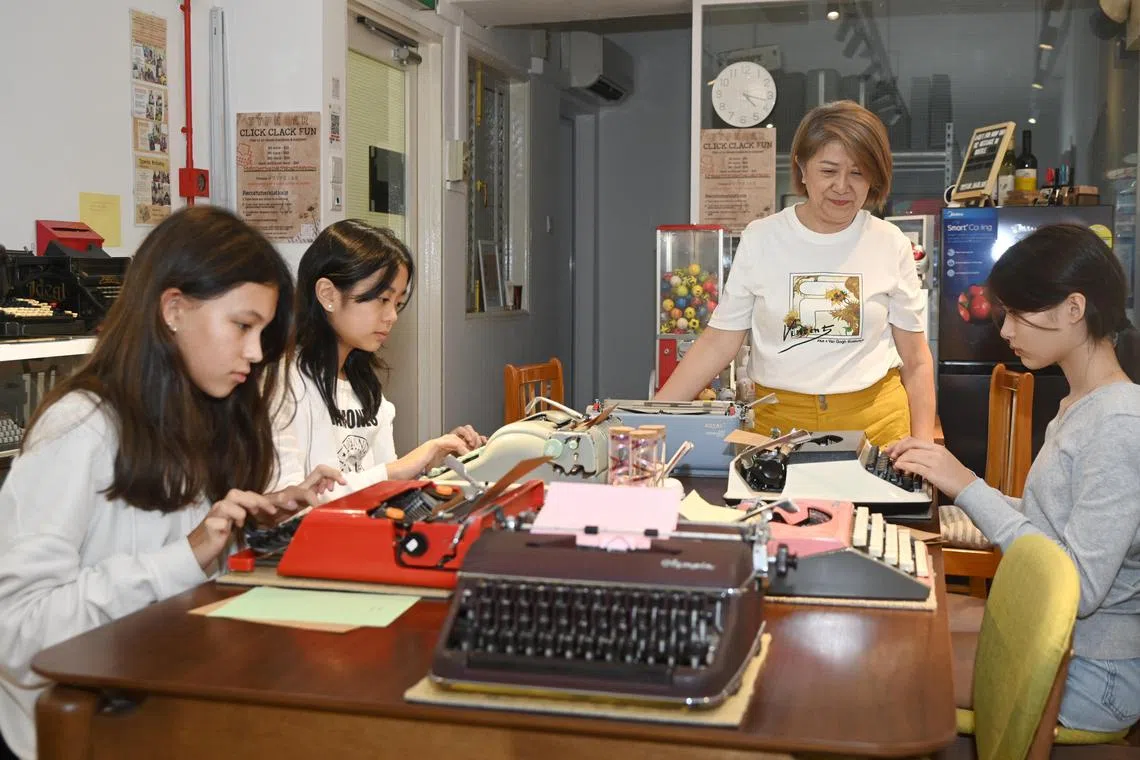Typewriters popular again in Singapore, not just for aesthetic reasons
Sign up now: Get ST's newsletters delivered to your inbox

Mr Jason Chong has been running antique typewriter shop Vintage Empire for almost a decade.
ST PHOTO: EUGENE TAN
Follow topic:
SINGAPORE – The ubiquitous clickety-clack of their keys was supposed to have gone the way of the dodo.
But typewriters have become fashionable again.
People continue to come up with novel ways to make typewriters relevant in the digital age – from a stress-relieving pastime to a useful tool for engaging children.
This is especially so for those with a literary bent, says Mr Jason Chong, who has been running antique typewriter shop Vintage Empire for almost a decade.
One of his customers, writer Lee Wen-Yi, was given a Corona No. 3 folding typewriter by her mother last Christmas. She had it restored by Mr Chong.
“It’s my favourite present,” says the 24-year-old, who plans to use it for cards and special occasions.
While she enjoys the experience of typing on a typewriter, she says that she uses it more for aesthetic reasons than functional ones. According to Mr Chong, her 1920s typewriter had not been maintained well enough to be used heavily.
She adds: “I write prose so it’s a bit more unwieldy, but it’s good for little snippets. Book aesthetics are so big now with Booktok and Bookstagram, so it’s also a convenient prop.”
Booktok and Bookstagram refer to book-related content on social media platforms
Mr Chong, whose shop is in Marine Drive, estimates that he sells four typewriters a week, adding that the demand for typewriter repairs has tripled in the last five years.
While his oldest clients are well into their 70s, he says: “Young people tend to be very fascinated because many have never seen one before and want to know what it is.”
He also notes that many of the typewriters his customers are interested in are “older than Singapore”.
Mr Adrian Chan – a history buff and former film archivist – started collecting typewriters two years ago. He has about 10 antique typewriters and plans on displaying them in his house after it has been renovated.
Originally drawn to typewriters for their design history, the 48-year-old found himself using them increasingly to write letters to his partner.

Mr Adrian Chan’s work area at home includes two typewriters. The history buff and former film archivist started collecting typewriters two years ago.
PHOTO: COURTESY OF ADRIAN CHAN
“I enjoy the tactile aspect of the keys because each typewriter feels different, and they’re a good way to de-stress after working on a laptop all day,” he says.
Typewriters at Vintage Empire range from $250 to $480, while repairs average between $90 and $160.
Checks by The Straits Times found that some antique typewriters listed on Carousell are going for more than a thousand dollars.
However, there are also avenues to try one’s hand at typewriting without the commitment of owning one.
Opened last November, Type8ar in Haji Lane is a family-run business offering guests a space to try out typewriters in person.
It has 50 typewriters and they come with various typefaces and fonts. It also provides stationery such as card stock, ink stamps and washi tape for people to experiment with as they put out typewritten works.
The business is run by a couple, Ms Adeline Tan, 66, and her husband Lionel, 68. The typewriters belong to their daughter Claudia, who has been collecting them for more than 15 years.
“Our vision is to offer a physical space and community for typewriter enthusiasts, or even people who are just keen to learn more,” Ms Claudia Tan, 38, says.

Ms Adeline Tan of Type8ar with three young customers on July 14. Type8ar is a space where customers can try out different typewriters.
ST PHOTO: DESMOND WEE
Each day, some five to 20 walk-in customers use Type8ar’s typewriters for creative work, personal letters or journalling, for which the shop provides a ring-bound journal.
Those looking for something different can opt for specific activities such as a game where guests follow a set of instructions to create a typed artwork, revealing a mystery picture at the end.
The shop’s prices are pegged to the duration customers use the typewriters, ranging from 30 minutes to two hours, with prices from $18 to $38. Every additional hour is $10.
Type8ar also holds regular workshops, which include a sharing of typewriter fun facts, a demonstration session, a speed-typing competition and a capsule letter-writing activity. Each session has between five and 15 participants.
These workshops are available upon request and are usually taken up by people celebrating special occasions or companies looking for team-bonding activities.
A 2½-hour workshop costs $68 a person.
Most customers chance upon Type8ar while walking along Haji Lane or through social media, such as Ms Ynez Lim, who discovered it on Instagram.
The 27-year-old English teacher says: “The couple were very passionate about typewriters and patiently explained to us how to use them. We picked out our favourite typewriters based on the font and started typing away.”
Pharmacist Tan Kai Hui, 37, tried out Type8ar’s workshop earlier in July as it was something unusual and she wanted to give her children a chance to appreciate how technology has evolved.
“They might have seen typewriters, but it’s not easy to try one,” she says.
Asked how the experience differed from the typical digital experiences her children have had, she says they had to learn the importance of planning as the typewriter did not allow them to delete their work.
Ms Lim, who says she was “immersed in the therapeutic experience of connecting with myself and my emotions through words” during the writing process, agrees.
“As the typewriter did not allow for corrections to be made, unlike modern computers, it didn’t give room for edits. I made a few mistakes along the way and wanted to change a few words, but I embraced whatever I typed in its original form,” she says.
“There is beauty in that,” she adds.
Even schools are getting in on the act, with many buying or renting typewriters in huge numbers, said Mr Chong, who also noted that the shipping industry has continued to use typewriters to fill out forms at sea.
He said that schools use typewriters to encourage students to put more thought into their writing.
“They bought a lot for teaching because they feel that students nowadays are very distracted. Their vocabulary and writing skills are not as strong because of Netflix and social media,” he said.
Asked if she would introduce typewriters into her classroom, Ms Lim said: “My literature students love writing poetry and I think they will definitely enjoy using these typewriters to type out their creative works.”
She added that with all students using laptops and tablets these days, much of their writing is done online and has resulted in a tendency for students to “copy and paste” information from online sources.
“If I could switch things up and bring typewriters into the classroom, I think it would really make the writing experience a memorable one,” she said.
This is because there will be no interference from phones or computers, allowing students to connect solely with their own thoughts. It may even spark an interest in writing for those who dislike the process since it is such a novel experience.
“I also hope students can learn to embrace originality and mistakes – it’s all part and parcel of writing.”


